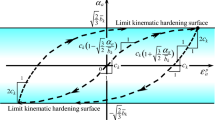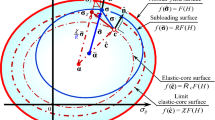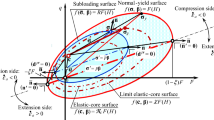Abstract
The subloading surface model is endowed with the intrinsic far-reaching ability to describe the wide classes of irreversible mechanical behavior, e.g. the monotonic and the cyclic loading behavior of elastoplastic and viscoplastic materials, the friction behavior and the crystal plastic behavior as has been examined in the former paper (Hashiguchi in Arch Comput Methods Eng 20:361–417, 2013). However, the past formulations of the subloading surface model have contained several inexact equations, which have been modified repeatedly since the concept of the subloading surface was proposed in 1977 (Hashiguchi and Ueno 1977). The exact formulation is presented first in this article for the hypoelastic-based plasticity, which enjoys the distinguished superiority in the both aspects of the description of material behavior in high accuracy and of the numerical calculation in high efficiency. It is further provided for all the four basic frameworks, i.e. the infinitesimal hypoelastic-based plasticity, the infinitesimal hyperelastic-based plasticity, the hypoelastic-based plasticity and the multiplicative hyperelastic-based plasticity for finite strain. Further, the subloading-crystal plasticity model is formulated modifying the former one (Hashiguchi 2013) by incorporating the decomposition of the crystalline shear strain rate into the elastic and the plastic parts. This would be the guidebook to the subloading surface model and also the memorial monograph for the historical development of the subloading surface model.





















Similar content being viewed by others
References
Armstrong PJ, Frederick CO (1966) A mathematical representation of the multiaxial Bauschinger effect. CEGB Report RD/B/N 731 (or in: Mater High Temp 24:1–26 (2007))
Asaoka A, Nakano M, Noda T (1997) Soil–water coupled behaviour of heavily overconsolidated clay near/at critical state. Soils Found 37(1):13–28
Bassani JL, Wu TY (1991) Latent hardening in single crystals II: Theory analytical characterization and predictions. Proc R Soc Lond A 435:21–41
Belytschko T, Liu WK, Moran B (2000) Nonlinear finite elements for continua and structures. Wiley, London (see also, Belytschko T, Liu WK, Moran B, Elkhodary KI (2014) 2nd edn)
Chaboche JL, Dang-Van K, Cordier G (1979) Modelization of the strain memory effect on the cyclic hardening of 316 stainless steel. In: Transactions on 5th international conference SMiRT, Berlin, Division L. paper no. L. 11/3
de Souza EN, Peric D, Owen DJR (2008) Computational methods for plasticity. Wiley, London
Dafalias YF (1985) The plastic spin. J Appl Mech (ASME) 52:865–871
Dafalias YF (1998) Plastic spin: necessity or redundancy ? Int. J. Plasticity 14:909–931
Dafalias YF, Popov EP (1975) A model of nonlinearly hardening materials for complex loading. Acta Mech 23:173–192
Drucker DC (1988) Conventional and unconventional plastic response and representation. Appl Meek Rev (ASME) 41:151–167
Harder J (1999) A crystallographic model for the study of local deformation processes in polycrystals. J Plast 15:605–624
Hashiguchi K (1977) An expression of anisotropy in a plastic constitutive equation of soils. In: Constitutive equations of soils (proceedings of 9th soil mechanics and foundation engineering, special session 9), Tokyo. JSSMFE, pp 302–305
Hashiguchi K (1980) Constitutive equations of elastoplastic materials with elastic–plastic transition. J Appl Mech (ASME) 47:266–272
Hashiguchi K (1985) Subloading surface model of plasticity. In: Constitutive laws of soils (proceedings of discussion session 1A, 11th international conference on soil mechanics foundation and engineering), San Francisco, pp 127–130
Hashiguchi K (1989) Subloading surface model in unconventional plasticity. Int J Solids Struct 25:917–945
Hashiguchi K (1993) Fundamental requirements and formulation of elastoplastic constitutive equations with tangential plasticity. Int J Plast 9:525–549
Hashiguchi K (1993) Mechanical requirements and structures of cyclic plasticity models. Int J Plast 9:721–748
Hashiguchi K (1994) Loading criterion. Int J Plast 8:871–878
Hashiguchi K (1997) The extended flow rule in plasticity. Int J Plast 13:37–58
Hashiguchi K (1998) The tangential plasticity. Mech Mater 4:652–656
Hashiguchi K (2000) Fundamentals in constitutive equation: continuity and smoothness conditions and loading criterion. Soils Found 40(3):155–161
Hashiguchi K (2007) Extended overstress model for general rate of deformation including impact load. In: Proceedings of 13th international symposium on plasticity and its current applications, pp 37–39
Hashiguchi K (2008) Extension of the formulation for cyclic stagnation of isotropic-hardening of metals by the subloading surface concept. In: Proceedings of international symposium on plasticity, pp 346–348
Hashiguchi K (2013) General description of elastoplastic deformation/sliding phenomena of solids in high accuracy and numerical efficiency: subloading surface concept. Arch Comput Methods Eng 20:361–417
Hashiguchi K (2013) Elastoplasticity theory, Lecture notes in applied and computational mechanics, 2nd edn. Springer, Berlin
Hashiguchi K (2015) Formulation of subloading-damage model. In: Proceedings of JSME, Kyushu Branch
Hashiguchi K, Chen Z-P (1998) Elastoplastic constitutive equations of soils with the subloading surface and the rotational hardening. Int J Numer Anal Methods Geomech 22:197–227
Hashiguchi K, Mase T (2011) Physical interpretation and quantitative prediction of cyclic mobility by the subloading surface model. Japan Geotech J 6:225–241
Hashiguchi K, Oka M (2014) Subloading-damage model. In: Proceedings of 63rd National Congress of Theoretical and Applied Mechanics, Japan OS16-01-01
Hashiguchi K, Okamura K (2014) Subloading phase-transformation model. In: Proceedings of 27th JSME Computational Mechanics Division conference OS17-1707
Hashiguchi K, Okayasu T, Saitoh K (2005) Rate-dependent inelastic constitutive equation: the extension of elastoplasticity. Int J Plast 21:463–491
Hashiguchi K, Ozaki S (2008) Constitutive equation for friction with transition from static to kinetic friction and recovery of static friction. Int J Plast 24:2102–2124
Hashiguchi K, Ozaki S, Okayasu T (2005) Unconventional friction theory based on the subloading surface concept. Int J Solids Struct 42:1705–1727
Hashiguchi K, Protasov A (2004) Localized necking analysis by the subloading surface model with tangential-strain rate and anisotropy. Int J Plast 20:1909–1930
Hashiguchi K, Saitoh K, Okayasu T, Tsutsumi S (2002) Evaluation of typical conventional and unconventional plasticity models for prediction of softening behavior of soils. Geotechnique 52:561–573
Hashiguchi K, Tsutsumi S (2001) Elastoplastic constitutive equation with tangential stress rate effect. Int J Plast 17:117–145
Hashiguchi K, Tsutsumi S (2003) Shear band formation analysis in soils by the subloading surface model with tangential stress rate effect. Int J Plast 19:1651–1677
Hashiguchi K, Tsutsumi S (2006) Gradient plasticity with the tangential subloading surface model and the prediction of shear band thickness of granular materials. Int J Plast 22:767–797
Hashiguchi K, Ueno M (1977) Elastoplastic constitutive laws of granular materials. In: Murayama S, Schofield AN (eds) Constitutive equations of soils (proceedings 9th international conference soil mechanics found engineering, special session 9), Tokyo, JSSMFE, pp 73–82
Hashiguchi K, Ueno M, Ozaki T (2012) Elastoplastic model of metals with smooth elastic–plastic transition. Acta Mech 223:985–1013
Hashiguchi K, Yamakawa Y (2012) Introduction to finite strain theory for continuum elasto-plasticity. Wiley series in computational mechanics. Wiley, London
Hashiguchi K, Yoshimaru T (1995) A generalized formulation of the concept of nonhardening region. Int J Plast 11:347–365
Higuchi R, Okamura K, Ohta F, Hashiguchi K (2014) Extension of subloading surface model for accurate prediction of elastoplastic deformation behavior of metals with cyclic softening. Bull JAME Ser A. doi:10.1299/transjsme.2014smm0082
Hill R (1967) On the classical constitutive relations for elastic/plastic solids. In: Recent progress in applied mechanics, pp 241–249
Hill R (1983) On the intrinsic eigenstates in plasticity with generalized variables. Math Proc Camb Philos Soc 93:177–189
Jaumann G (1911) Geschlossenes System physicalisher und chemischer Differentialgesetze. Sitzber. Akad. Wiss. Wien (IIa) 120:385–530
Khojastehpour M, Hashiguchi K (2004) The plane strain bifurcation analysis of soils by the tangential-subloading surface model. Int J Solids Struct 41:5541–5563
Khojastehpour M, Hashiguchi K (2004) Axisymmetric bifurcation analysis in soils by the tangential-subloading surface model. J Mech Phys Solids 52:2235–2262
Khojastehpour M, Murakami Y, Hashiguchi K (2006) Antisymmetric bifurcation in a circular cylinder with tangential plasticity. Mech Mater 38:1061–1071
Mandel J (1972) Director vectors and constitutive equations for plastic and viscoplastic media. In: Sawczuk A (ed) Problems of plasticity (proceedings of international symposium on foundation of plasticity), Noordhoff, pp 135–141
Masing G (1926) Eigenspannungen und Verfestigung beim Messing. In: Proceedings of 2nd International Congress of Applied Mechanics, Zurich, pp 332–335
Miehe C (1996) Exponential map algorithm for stress updates in anisotropic multiplicative elastoplasticity for single crystals. Int J Numer Methods Eng 39:3367–3390
Mroz Z (1967) On the description of anisotropic workhardening. J Mech Phys Solids 15:163–175
Ohno N, Wang JD (1993) Kinematic hardening rules with critical state of dynamic recovery. Part I: Formulation and basic features for ratcheting behavior. Part II: Application to experiments of ratcheting behavior. Int J Plast 9:375–403
Pedroso DM (2014) The subloading isotropic plasticity as a variable modulus model. Comput Geotech 61:230–240
Peirce D, Asaro JR Asaro, Needleman A (1982) Overview 21: An analysis of nonuniform and localized deformation in ductile single crystals. Acta Metall 30:1087–1119
Peirce D, Asaro JR Asaro, Needleman A (1983) Overview 32: Material rate dependence and localized deformation in crystal solids. Acta Metall 31:1951–1976
Perzyna P (1963) The constitutive equations for rate sensitive plastic materials. Q Appl Math 20:321–332
Perzyna P (1966) Fundamental problems in viscoplasticity. Adv Appl Mech 9:243–377
Prager W (1956) A new methods of analyzing stresses and strains in work hardening plastic solids. J Appl Mech (ASME) 23:493–496
Prager W (1961) Linearization in visco-plasticity. Ing Archiv 15:152–157
Rudnicki JW, Rice JR (1975) Conditions for the localization of deformation in pressure-sensitive dilatant materials. J Mech Phys Solids 23:371–394
Simo JC (1998) Numerical analysis and simulation of plasticity. In: Ciarlet PG, Lions JL (eds) Handbook of numerical analysis, vol 6, part 3. Elsevier, Amsterdam
Simo JC, Hughes TJR (1998) Computational inelasticity. Springer, Berlin
Truesdell C (1955) Hypo-elasticity. J Ration Mech Anal 4:83–133
Weber G, Anand L (1990) Finite deformation constitutive equations and a time integration procedure for isotropic, hyperelastic–viscoplastic solids. Comput Methods Appl Mech Eng 79:173–202
Wongsaroj J, Soga K, Mair RJ (2007) Modeling of long-term ground response to tunneling under St James’ Park, London. Geotechnique 57:75–90
Xu B, Jiang Y (2004) A cyclic plasticity model for single crystals. Int J Plast 20:2161–2178
Yamakawa Y, Hashiguchi K, Ikeda K (2010) Implicit stress-update algorithm for isotropic Cam-clay model based on the subloading surface concept at finite strains. Int J Plast 26:634–658
Yoshida F, Uemori T (2002) Elastic–plastic behavior of steel sheets under in-plane cyclic tension-compression at large strain. Int J Plast 18:633–659
Zbib HM, Aifantis EC (1988) On the concept of relative and plastic spins and its implications to large deformation theories. Part I: Hypoelasticity and vertex-type plasticity. Acta Mech 75:15–33
Acknowledgments
The author would like to express his sincere gratitude to Professor Genki Yagawa (Emeritus Professor, University of Tokyo and Toyo University) for inviting the author to contribute to this journal, highly appreciating this monograph written as the compilation of the subloading surface model which has been developed and established through the author’s life. He is also indebted to Prof. Masami Ueno, University of Ryukyus for the valuable discussions on the description of cyclic loading behavior, Prof. Yuki Yamakawa, Dept. Civil Eng., Tohoku University, for valuable comments and suggestions on the finite strain elastoplasticity and a lot of overall valuable advices for the exposition in this article by the critical reading and Dr. Kazuo Okamura, Fellow of Nippon Steel & Sumitomo Metal Corporation for providing enlightening advices for the crystal plasticity of metals.
Author information
Authors and Affiliations
Corresponding author
Additional information
Koichi Hashiguchi is a Emeritus Professor of Kyushu University.
Rights and permissions
About this article
Cite this article
Hashiguchi, K. Exact Formulation of Subloading Surface Model: Unified Constitutive Law for Irreversible Mechanical Phenomena in Solids. Arch Computat Methods Eng 23, 417–447 (2016). https://doi.org/10.1007/s11831-015-9148-x
Received:
Accepted:
Published:
Issue Date:
DOI: https://doi.org/10.1007/s11831-015-9148-x




